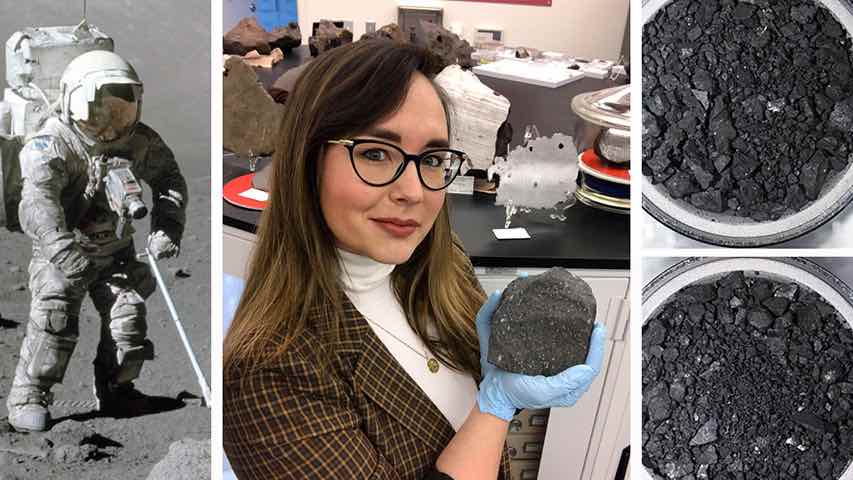We met Jemma Davidson, Cosmochemist, Petrologist and Planetary Scientist at Arizona State University’s Buseck Center for Meteorite Studies in Tempe (Arizona, USA). She studies the primitive astromaterials, the lunar samples brought to Earth by NASA’s Apollo missions, the Hayabusa-returned samples and martian meteorites. Recently she has been selected by NASA to conduct laboratory analyzes on Phobos samples, which will be brought to Earth by JAXA’s Martian Moons eXploration (MMX) mission.
The JAXA’s MMX mission will be launched in 2024 with the goal of visiting the two moons of Mars Phobos and Deimos. In addition, a lander will land on Phobos and collect samples, which will be brought to Earth in 2029.
Why is it so important to study asteroids, martian meteorites, carbonaceous chondrites and interplanetary dust particles? How do you understand how they were born and how they evolved?
Samples from space can tell us about all stages of Solar System evolution – from the formation of the Solar System (by studying carbonaceous chondrites, asteroids, and interplanetary dust particles) to later stages of planetary evolution (by studying martian meteorites, lunar meteorites, and Apollo samples). One of the questions that drives us is why is Earth so special? How did it evolve to the point where it could support life? Did comets and/or asteroids deliver the ingredients for life to Earth? To understand why Earth looks the way it does, we have to understand what the Solar System formed form and what processes occurred to make Earth the complex, life-supporting planet we see today.
Is it true that the chemical reactions that take place in asteroids can produce the ingredients of life? Were the ingredients that gave rise to life on Earth brought by asteroids?
Meteorites and returned samples (such as Hayabusa and Hayabusa2 samples) from asteroids contain organic molecules and water, which are both essential ingredients for life. While life has not been found in rocks from space, the building blocks for life have, so it is very possible that meteorites delivered the building blocks of life to Earth!
Credit: NASA Johnson
You have been selected by NASA to conduct laboratory analyzes of the samples brought back from Phobos. How will you study Mars moon samples? What are you thinking of discovering?
I have been chosen to study a group of minerals in the Phobos samples, called opaque minerals, which include magnetite, chrome-spinel, and sulfide. They are called opaque minerals because they do not transmit light when looked at with a microscope, but they are incredibly interesting. Opaque minerals are very powerful to study because they record the conditions under which they were formed and altered so we can use them to learn about how Phobos formed.
I will study the chemical and isotope compositions of the Phobos samples, which are very characteristic of where they formed. Ultimately, we want to know whether Phobos is an asteroid that was captured by Mars’ gravity or if it formed by a giant impact with Mars, similar to our Moon that formed from a giant impact with Earth. Because the surface of Phobos likely has meteorites from Mars (knocked off Mars by many impacts over Mars’ history), studying samples from Phobos will also tell us about the history of Mars!
Credit: JAXA
In your career you have studied the lunar samples brought to Earth by NASA’s Apollo missions, you have analyzed the Hayabusa-returned particles from asteroid Itokawa, and then you have also worked on NASA’s OSIRIS-REX mission, which will bring samples of an asteroid to Earth. Do these samples collected in space, which look different to our eyes, have something in common? What did they teach you?
Space rocks come from bodies that record different times and stages of our Solar System’s history. For example, Hayabusa-returned samples can help us understand how small asteroids formed and evolved in the very earliest Solar System history, while Apollo samples can teach us how the Moon formed and evolved as a relatively large body. By studying space rocks returned by spacecraft, we can learn about the entire history of our Solar System!
What emotions do you feel when studying space samples born billions of years ago? What do you love about your job?
I love studying space rocks – it is one of the coolest jobs in the world. These space rocks formed before humans existed! It is incredibly exciting that we can learn a phenomenal amount of information about our Solar System from tiny grains of dust that formed billions of years ago. One of my favourite things about my job is that I am always learning something new and looking at rocks no one has looked at before!

